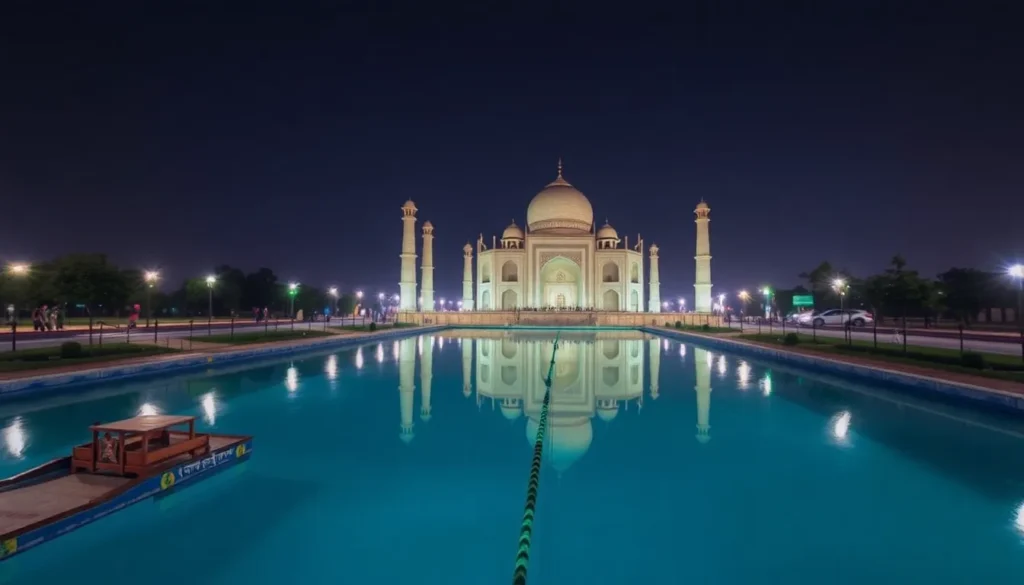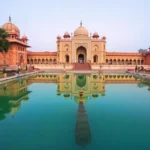Interesting and Uncommon Facts About India You Might Not Know

- Understanding the Cost of Living in India
- The Chaotic Charm of Indian Trains
- Encountering India's Diverse Wildlife
- The Intriguing Head Shake: Yes or No?
- Born to Horn: The Soundscape of India
- The Unique Place of Hijras: India's Third Gender
- Unexpected Celebrity: The Indian Paparazzi
- Bollywood's Influence and Censorship
- Workplace Safety: A Different Perspective
- Betel and the 'Dracula' Teeth
- Public Displays of Affection
- Curiosity in the Eyes of Locals
- Creative Advertising: Painting Instead of Posting
- The Challenge of Waste Management
- Exploring the Unique Bathroom Experience
- Grooming and Vanity in Indian Culture
When you think of India, prepare to be amazed. This vibrant country is a tapestry of cultures, traditions, and peculiarities that can leave even the most seasoned travelers in awe. From the bustling streets of its cities to the tranquil beauty of its landscapes, India is a land of contrasts. Join us as we delve into the curiosities and oddities of India that continue to captivate adventurers from around the globe.
Understanding the Cost of Living in India
Traveling to India is often associated with affordability, but just how cheap can it be? While some travelers report rising costs, with a bit of adaptability and local insight, you can experience India on a budget. It’s crucial to embrace the local lifestyle to avoid being tagged with "tourist prices." For instance, if you’re purchasing packaged goods like snacks or toiletries, remember that their prices are often displayed right on the packaging—no need to ask!
When it comes to cash transactions, stay vigilant. Vendors might give you your change in two parts, leading to potential confusion and loss if you don’t pay attention. Here are some quick tips to help you navigate prices effectively:
- Always look at the package for prices.
- Be cautious about how change is given.
- Negotiate prices when shopping in markets.
- Use cash to avoid extra fees from card transactions.
The Chaotic Charm of Indian Trains
Traveling by train in India is an adventure in itself. There are two types of Indian train passengers: those who rush to board at the first opportunity and those who wait patiently until the train is in motion. The former group can be quite a sight, running and pushing their way onto the train as if their lives depend on it!
Once aboard, the experience shifts dramatically. Vendors shout out various snacks and beverages, creating a lively atmosphere reminiscent of a market. The train becomes a melting pot of flavors and sounds, offering everything from chai to biryani. As the journey progresses, passengers often prepare for the final act: the rush to disembark, with many attempting to leap off while the train is still moving.
Some tips for train travel in India include:
- Be aware of your belongings, especially during busy boarding times.
- Try local snacks offered by vendors for an authentic experience.
- Stay alert as the train approaches your stop to avoid a chaotic exit.
Encountering India's Diverse Wildlife
One of the fascinating aspects of India is its wildlife, often seen roaming freely in urban settings. Streets abound with a variety of animals, from playful squirrels to majestic cows, which hold sacred status in Hindu culture, symbolizing motherhood and fertility. Encountering monkeys can be both amusing and challenging, especially if they decide to snatch your snacks or personal belongings!
Other animals you might encounter include:
- Street dogs and cats.
- Camels and elephants, especially in rural areas.
- Many species of birds, including peacocks.
In India, cows are revered and freely roam the streets. It’s said that being touched by a cow's tail brings good luck—a belief many travelers find amusing as they navigate around these gentle creatures.
The Intriguing Head Shake: Yes or No?
One of the most charming yet perplexing aspects of communication in India is the famous head shake. This gesture can signify various responses—particularly an affirmative one—but its meaning can vary widely based on context. Sometimes it translates to a hesitant yes, a noncommittal no, or even uncertainty. Understanding this unique form of communication can be both fun and confusing for newcomers.
Next time you’re in India, try to decode this culturally rich signal!
Born to Horn: The Soundscape of India
In India, honking is not just a nuisance; it’s a fundamental part of daily life. The phrase “born to horn” perfectly encapsulates how integral sound is to Indian streets. Vehicles are often adorned with signs that read “Please horn,” indicating that honking is a polite way to signal your presence.
The constant symphony of horns can feel overwhelming at first, but it soon becomes an expected backdrop to the bustling life around you. Here are a few things to keep in mind:
- Embrace the noise as part of the cultural experience.
- Be cautious when crossing streets—drivers may not stop for pedestrians.
- Learn to interpret various honks to understand the traffic flow.
The Unique Place of Hijras: India's Third Gender
The Hijra community holds a unique position in Indian culture, often considered a third gender. Comprising individuals who may be transgender or intersex, Hijras have existed in India for centuries. Their presence is both powerful and complex; they are sometimes invited to bless newborns, believed to bring good fortune.
The Hijras undergo a significant transformation, often involving rituals that symbolize their new identity. While many Hijras live on the fringes of society, they remain an integral part of India's cultural fabric, often seen begging or performing in public spaces.
Here are some insights about Hijras:
- They play a role in various cultural ceremonies.
- Many face societal challenges and discrimination.
- They symbolize acceptance and the fluidity of gender in Indian culture.
Unexpected Celebrity: The Indian Paparazzi
Have you ever felt like a celebrity? In India, being a foreigner can often lead to unexpected fame. Many locals are eager to take photos with tourists, sometimes treating them as celebrities themselves. This phenomenon can be amusing, albeit a bit overwhelming, as you may find yourself posing for pictures frequently.
During our travels, we encountered countless requests for photographs, which can become quite tiring after a while. It’s essential to keep in mind that this is often a gesture of admiration and curiosity rather than an invasion of privacy.
Bollywood's Influence and Censorship
No discussion of India is complete without mentioning Bollywood, the vibrant film industry that captivates millions. Bollywood actors are akin to demigods, adored by fans across the nation. However, these films often come with strict censorship rules, affecting the portrayal of romance, violence, and substance use.
For instance, you may find that kisses are rare, and smoking scenes come with disclaimers about health risks. Despite these constraints, the colorful and dramatic storytelling remains a significant draw for audiences.
Workplace Safety: A Different Perspective
Workers in India often face challenging and hazardous conditions. The construction industry, for instance, utilizes minimal safety measures, with workers balancing precariously on bamboo scaffolding. Such practices highlight a vastly different approach to workplace safety compared to many Western countries.
Even in urban settings, you’ll notice a lack of safety gear among workers. Here are a few observations regarding labor practices:
- Minimal regulation regarding workplace safety.
- High levels of risk associated with manual labor.
- Workers often come ill-prepared for dangerous tasks.
Betel and the 'Dracula' Teeth
In India, it’s common to see individuals with red-stained teeth due to betel chewing. This practice, which involves wrapping areca nut and lime in a betel leaf, is popular across the country and has addictive qualities. While it’s a cultural staple, the resulting red-tinged teeth can be quite striking, earning some individuals the nickname “Dracula.”
Public Displays of Affection
In India, public displays of affection can be quite different from what you might expect. While you’re likely to see men walking hand-in-hand, it’s rare to witness couples expressing romantic affection in public. This cultural norm can be surprising for visitors. Instead of romantic gestures, friendships among men often manifest as physical affection.
Curiosity in the Eyes of Locals
As a traveler, you may find yourself under the watchful eyes of curious locals. This phenomenon, driven by a mix of intrigue and hospitality, can feel overwhelming at times. If you find yourself in this situation, you have a couple of options:
- Smile and engage with those watching you.
- Return their gaze to create a light-hearted moment.
- Embrace the attention as part of the cultural experience.
Creative Advertising: Painting Instead of Posting
In smaller towns, you might notice a unique approach to advertising. Instead of posters or billboards, many businesses opt for murals painted directly on walls. This artistic form of advertising provides a colorful and engaging aspect to local culture, showcasing creativity in unexpected places.
The Challenge of Waste Management
One pressing issue that travelers often encounter in India is waste management. Littering is prevalent, particularly near waterways and in urban areas. The absence of trash cans contributes to this problem, resulting in unsightly scenes. While cows once played a role in cleaning up waste, their diets now include everything from plastic to discarded food.
Exploring the Unique Bathroom Experience
Using the restroom in India can be a transformative experience. Unlike Western-style toilets, you might encounter squat toilets that require a different approach. Moreover, public bathrooms can vary widely in cleanliness and facilities, often lacking basic amenities.
Initially daunting, navigating these new restroom cultures can be part of the adventure. Here are a few things to remember:
- Be prepared for squat toilets in many areas.
- Carry your own toilet paper and hand sanitizer.
- Embrace the cultural differences as part of your journey.
Grooming and Vanity in Indian Culture
In India, grooming is taken seriously, particularly among men. Barbershops are ubiquitous, offering not just haircuts but also a range of grooming services, from shaves to massages. Men often take pride in their appearance, and vibrant hair colors are not uncommon, with henna being a popular choice.
While you’ll find many salons catering to men, options for women can be limited. This focus on grooming reflects a cultural emphasis on personal appearance and cleanliness.
India is a land rich in experiences, and the curiosities that abound serve to enhance its allure. With every corner you turn, a new discovery awaits, inviting you to explore the depths of its culture and traditions. If you know any other curiosities and oddities about India, share them, and let’s keep this fascinating conversation going!
| Save on Your Trip |
| Find cheap flights to India here |
| Book accommodation at the best rates here |
| Reserve activities in Spanish in India here |
| Get 5% off your travel insurance IATI here |
| Book airport transfers here |
| Learn how to withdraw money without fees here |
| Get a 5% discount on your eSIM from Holafly here |
| Rent a car with the best deals here |
| The best books and travel guides here |
| Check out all our articles about India |






Deja una respuesta